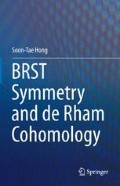Abstract
In the framework of the Dirac quantization with the second class constraints, a free particle moving on surface of (d − 1)-dimensional sphere has ambiguity in its energy spectrum due arbitrary shift of canonical momenta. In this chapter, we show that this spectrum obtained by the Dirac method can be consistent with that of the improved Dirac Hamiltonian formalism at the level of the first class constraint by fixing ambiguity, and then we discuss its physical consequences [48]. We next study a free particle system residing on torus to investigate its first class Hamiltonian associated with its Stückelberg coordinates [56].
Access this chapter
Tax calculation will be finalised at checkout
Purchases are for personal use only
Notes
- 1.
Here, one can include the constraint (2.44) explicitly in the Lagrangian to yield \(L_{T} = L + u(r - a),\) with Lagrangian multiplier u. One can then obtain primary constraint \(\Omega _{0} = p_{u},\) with p u being momentum conjugate to u. The Hamiltonian is then given by \(H_{T} = H - u(r - a),\) and successive time evolutions of \(\Omega _{0}\) reproduce \(\Omega _{1} = r - a\) and \(\Omega _{2} = p_{r}\). The condition \(\{\Omega _{2},H_{T}\} = 0,\) fixes value of u, namely \(u = -p_{\theta }^{2}/(\mathit{mr}^{3}) - p_{\phi }^{2}\sin \theta /[m(b + r\sin \theta ]^{3},\) which can terminate series of constraints. Since \(\Omega _{0}\) is first class, one can thus end up with two second class constraints \(\Omega _{1}\) and \(\Omega _{2}\), which are used in the context.
References
B. De Witt, Rev. Mod. Phys. 29, 377 (1957)
H. Dekker, Physica A 103, 586 (1980)
P. Dita, Phys. Rev. A 56, 2574 (1997)
E. Abdalla, R. Banerjee, Braz. J. Phys. 31, 80 (2001)
P.A.M. Dirac, Lectures in Quantum Mechanics (Yeshiva University, New York, 1964)
I.A. Batalin, E.S. Fradkin, Phys. Lett. B 180, 157 (1986)
A.J. Niemi, Phys. Lett. B 213, 41 (1988)
R. Banerjee, Phys. Rev. D 48, R5467 (1993)
S.T. Hong, Y.W. Kim, Y.J. Park, Phys. Rev. D 59, 114026 (1999)
S.T. Hong, W.T. Kim, Y.J. Park, Mod. Phys. Lett. A 15, 1915 (2000)
S.T. Hong, Mod. Phys. Lett. A 20, 1577 (2005)
W. Oliveira, J.A. Neto, Int. J. Mod. Phys. A 12, 4895 (1997)
S.T. Hong, Mod. Phys. Lett. A 20, 1577 (2005)
J.A. Neto, J. Phys. G 21, 695 (1995)
J.A. Neto, W. Oliveira, Int. J. Mod. Phys. A 14, 3699 (1999)
K. Fujii, N. Ogawa, Prog. Theor. Phys. Suppl. 109, 1 (1992)
T.D. Lee, Particle Physics and Introduction to Field Theory (Harwood, New York, 1981)
N. Vilenkin, Special Functions and the Theory of Group Representations (American Mathematical Society, Providence, 1968)
P.M. Morse, H. Feshbach, Methods of Theoretical Physics (McGraw-Hill, New York, 1953)
Author information
Authors and Affiliations
Rights and permissions
Copyright information
© 2015 Springer Science+Business Media Dordrecht
About this chapter
Cite this chapter
Hong, ST. (2015). Hamiltonian Quantization with Constraints. In: BRST Symmetry and de Rham Cohomology. Springer, Dordrecht. https://doi.org/10.1007/978-94-017-9750-4_2
Download citation
DOI: https://doi.org/10.1007/978-94-017-9750-4_2
Publisher Name: Springer, Dordrecht
Print ISBN: 978-94-017-9749-8
Online ISBN: 978-94-017-9750-4
eBook Packages: Physics and AstronomyPhysics and Astronomy (R0)

